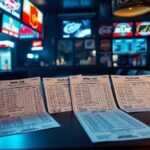This guide demystifies NHL betting odds, providing important insights for newcomers eager to engage in hockey wagering. Understanding the fundamentals of odds will enhance your betting experience, enabling you to make informed decisions that can lead to potential profits. From deciphering moneylines to grasping puck lines, we’ll walk you through the basics of sports gambling in hockey. With this knowledge, you can confidently navigate the world of NHL betting while avoiding common pitfalls that can impact your bankroll.
Understanding NHL Betting Odds
NHL betting odds represent the probability of outcomes in a game and dictate potential payouts. Understanding these odds is crucial for making informed bets. Various formats exist, each conveying information differently, impacting how bettors evaluate their wagering strategies.
Types of NHL Betting Odds
In hockey, three primary formats for odds exist: American, Decimal, and Fractional. Each format shows potential returns and reflects the bookmaker’s outlook on the game.
- American Odds: Usually presented as + or -, indicating the underdog or favorite.
- Decimal Odds: Simple to understand, showing total payout per unit wagered.
- Fractional Odds: Traditional format used in sportsbooks, emphasizing the profit relative to stake.
- Moneyline Bets: The most common, focusing on who will win.
- Point Spread: Aims to level the playing field between uneven teams.
Assume that you are analyzing a game with listed odds. Each format can guide your betting strategy and expectations for returns.
| Odds Format | Description |
| American Odds | Shows potential profit: +200 means $200 for a $100 bet. |
| Decimal Odds | Indicates the total return; a bet of $100 at 3.00 returns $300. |
| Fractional Odds | Expressed as a fraction, like 5/2, representing profit for every bet unit. |
| Moneyline Bets | Focus on winners; clear cut for straightforward betting. |
| Point Spread | Covers the margin for more competitive betting opportunities. |
How Odds Work in Hockey
Hockey odds reflect expectations from the betting market regarding team performance. They are determined by bookkeepers analyzing statistics, current form, injuries, and other factors. For instance, if a dominant team faces a weaker opponent, the odds will likely favor the stronger side. Conversely, if an underdog shows recent improvement, odds may adjust, affecting how much you could win.
Understanding how odds operate is fundamental for any bettor. In hockey, the likelihood of winning or losing is dynamically reflected through these odds. A team with a -150 moneyline means you must wager $150 to win $100, indicating it is favored heavily. Conversely, a team listed at +200 means a $100 bet could yield a $200 profit, showing it’s the underdog. The market constantly shifts, so staying updated on factors like injuries and performance trends can affect odds significantly. Tracking these changes and evaluating the betting landscape widens options for strategic wagers, enhancing potential returns.
Tips for Beginner Bettors
Starting with NHL betting requires a keen understanding of various aspects that can influence outcomes. Here are vital tips to keep in mind:
- Set a budget for your wagers.
- Understand different bet types, like moneyline, puck line, and totals.
- Research matchup statistics before placing bets.
- Follow injury reports for teams and players.
- Shop around for the best odds across multiple sportsbooks.
Perceiving the game’s nuances will significantly enhance your betting experience.
Researching Teams and Players
Gaining insights into teams and individual player performance is paramount for informed betting. Look into each team’s historical data, strengths, weaknesses, and how they perform against specific opponents. Evaluating player statistics, including goals, assists, and on-ice time, allows bettors to gauge their impact on game outcomes. Monitoring off-ice factors like trades or contract negotiations can also affect team dynamics and performance.
Analyzing Recent Performance
Recent games provide critical context to understanding a team’s current form. Focus on their wins and losses, goal differentials, and how they performed against similar opponents. Examine their home and away statistics, as certain teams thrive in their home arenas. These trends can reveal potential betting opportunities and insight into how teams may match up.
Analyzing recent performance includes assessing not just wins and losses but contextual factors like quality of competition faced and current form over the last several games. For instance, if a team has won four out of its last five games but faced weaker opponents, the results may be misleading. In contrast, a team that has lost consecutively but faced top-tier competition may still demonstrate potential for a turnaround. Keep an eye on player slumps, line adjustments, and other variables that might indicate a team is either on the rise or decline. This deeper analysis enables more strategic betting decisions.
Step-by-Step Guide to Wagering
| Step | Description |
| 1. Set a Budget | Decide how much you can afford to gamble without affecting your finances. |
| 2. Research | Analyze team statistics, player performance, and recent games to inform your decision. |
| 3. Choose Your Bet Type | Select a bet type that aligns with your strategy, such as moneyline or puck line. |
| 4. Placing Your Bet | Finalize your wager through a trusted sportsbook, following necessary steps. |
| 5. Monitor Your Bets | Keep track of your bets and adjust strategies based on performance. |
Setting a Budget
Establishing a betting budget is fundamental for responsible gambling. Decide on a fixed amount that you are willing to risk, ensuring it fits within your financial limits. Never exceed this budget, treating it as a form of entertainment expense rather than an investment opportunity. Regularly reviewing your budget can aid in maintaining discipline and enhancing your wagering experience.
Placing Your Bet
With your budget and research in place, the next step focuses on executing your wager through a sportsbook. Choose a reputable online platform or visit a physical location to ensure security. Select the desired match and type of bet, enter the stake amount, and confirm your wager. Always review the odds and bet slip before finalizing the process to prevent any errors that might affect your potential payout.
Different sportsbooks may have varied interfaces, but they generally guide users through the process. After selecting a match, navigate through the betting options, whether it’s a moneyline or spread bet. Engaging with live betting can provide real-time excitement, but be cautious as rapidly shifting odds can impact your betting strategy. Make use of features like cash-out options if available, which allow you to settle your bet before the completion of the event, offering flexibility and risk management.
Factors Influencing Betting Odds
NHL betting odds fluctuate based on a variety of factors that bettors must consider for informed wagering. Key elements include:
- Team performance
- Player statistics
- Recent head-to-head matchups
- Home ice advantage
- Injuries and roster changes
Recognizing these influences can significantly enhance your betting strategy.
Injuries and Roster Changes
Injuries to key players or last-minute roster changes can drastically affect a team’s performance and, consequently, the odds. For instance, if a star forward is sidelined, the team’s scoring potential diminishes, often leading to longer odds against them. Bettors should regularly check injury reports and lineup updates before placing wagers.
External Influences (Weather, Travel)
External factors like weather conditions and travel schedules play a vital role in shaping NHL betting odds. Inclement weather can impact fan attendance and, consequently, team morale, particularly in outdoor games. Additionally, extensive travel can lead to fatigue, particularly for teams playing back-to-back matches across time zones, which may hinder on-ice performance and affect betting odds.
Travel distance and schedule directly impact player stamina and mental readiness. For example, teams commenceing on long road trips may struggle with performance, while teams playing on home ice may maintain a more consistent energy level. With NHL teams often participating in tight schedules and varying time zones, understanding how these factors can affect performance is vital for making informed betting decisions.
Pros and Cons of NHL Betting
| Pros | Cons |
|---|---|
| Potential for significant profits | High risk of loss |
| Access to a vast amount of statistics | Can lead to addiction |
| In-game betting adds excitement | Challenging to predict outcomes |
| Variety of betting options available | Line fluctuations can affect bets |
| Engages fans with the sport | Can impact enjoyment of the game |
| Bonuses and promotions from sportsbooks | May lead to irresponsible gambling behavior |
| Knowledge of teams can improve betting skill | Complexity can be overwhelming |
| Opportunities to use analytics | Limited betting regulations in some regions |
| Ability to bet from anywhere with mobile apps | Potential for deception and scams |
| Social interaction with other bettors | Emotional decisions can lead to poor choices |
Benefits of Betting on Hockey
NHL betting offers numerous advantages that can enhance the experience for fans and bettors alike. The vast array of statistics available allows bettors to make informed decisions, and the unique nature of hockey—such as its fast pace and unpredictable outcomes—adds excitement to wagers. Moreover, the variety of betting options, including moneylines, spreads, and prop bets, enables individuals to tailor their strategies while engaging more deeply with the sport.
Risks and Drawbacks
While NHL betting can be thrilling, it comes with inherent risks that potential bettors must recognize. The volatility of game outcomes can lead to unexpected losses, and the accessibility of online sportsbooks may encourage impulsive betting behavior. Additionally, the complexity of odds and betting types can overwhelm newcomers, leading to uninformed wagers that diminish the enjoyment of the sport.
The potential drawbacks of NHL betting extend beyond financial loss. Bettors may experience heightened stress when following their wagers, which can detract from their enjoyment of the game. Furthermore, the temptation for over-betting can blur the line between entertainment and obsession, potentially leading to gambling addiction for susceptible individuals. Understanding these risks is necessary for anyone considering entering the world of NHL betting, ensuring a balance between fun and responsible wagering.
To wrap up
Considering all points, understanding NHL betting odds is crucial for anyone looking to engage in hockey wagering. By familiarizing yourself with the different types of odds, points spreads, and moneylines, you can make informed decisions and enhance your betting experience. A thorough grasp of game dynamics and team performance metrics further empowers you to strategize effectively. With patience and practice, beginners can develop their skills and potentially increase their chances of success in the exciting world of NHL betting.
FAQ
Q: What are NHL betting odds and how do they work?
A: NHL betting odds represent the likelihood of a specific outcome in a hockey game, expressed in various formats like decimal, fractional, or American odds. These odds determine how much money a bettor can win based on their wager. For example, if the odds for a team to win are set at +200 in American format, a $100 bet would yield a $200 profit if the team wins.
Q: What types of bets can I place on NHL games?
A: Common types of bets include moneyline bets (picking the winner), puck line bets (similar to point spread in other sports), and over/under bets (betting on total goals scored). Additionally, there are proposition bets (specific outcomes) and futures bets (predicting long-term outcomes like season champions).
Q: How can I analyze NHL betting odds before placing a wager?
A: To analyze NHL betting odds, consider factors such as team performance, player injuries, home and away records, historical matchups, and current trends. Studying these aspects helps assess the value of the odds and make more informed betting decisions based on the potential return.












